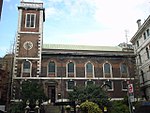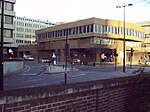BT Museum
1982 establishments in England1997 disestablishments in EnglandBT GroupDefunct museums in LondonLondon stubs ... and 4 more
Museums disestablished in 1997Museums established in 1982Telecommunications museums in the United KingdomUse British English from August 2015

The BT Museum was a telecommunications museum run by BT, that held artefacts and exhibits on the history of telecommunications in the United Kingdom. It was based in Baynard House in the Blackfriars district of London.It was originally opened as the Telecom Technology Showcase in 1982.It was closed to visitors in 1997, and was replaced in 2001 by the Connected Earth initiative.
Excerpt from the Wikipedia article BT Museum (License: CC BY-SA 3.0, Authors, Images).BT Museum
Queen Victoria Street, City of London
Geographical coordinates (GPS) Address Nearby Places Show on map
Geographical coordinates (GPS)
| Latitude | Longitude |
|---|---|
| N 51.511918333333 ° | E -0.10122333333333 ° |
Address
BT
Queen Victoria Street 135
EC4V 4AA City of London
England, United Kingdom
Open on Google Maps









